|
|
|
Sort Order |
|
|
|
Items / Page
|
|
|
|
|
|
|
| Srl | Item |
| 1 |
ID:
127778
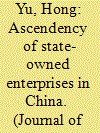

|
|
|
|
|
| Publication |
2014.
|
| Summary/Abstract |
The state sector still plays an important role in China's economy. One of the key development phenomena characterizing the Chinese economy is the rapid ascendency of state-owned enterprises (SOEs) and the resurgence of the state. The strength of China's SOEs is projected in the centrally administrated state-owned enterprises (CSOEs). They are the backbone of the national economy, spearheading national economic development and Beijing's 'going-out' strategy. The CSOEs have expanded their reach and increased their power, domestically and globally. In seeking to boost local GDP growth, the eastern provinces in China have joined the western provinces in a fierce contest to attract investment from SOEs. Nevertheless, the rapid ascendency of the SOEs has brought many negative consequences for China's economic, social and political development by causing conflict with the market-oriented development direction of Chinese economic reform and hindering fair competition between state-owned and non-state-owned enterprises.
|
|
|
|
|
|
|
|
|
|
|
|
|
|
|
|
| 2 |
ID:
105210


|
|
|
|
|
| Publication |
2011.
|
| Summary/Abstract |
The Chinese central government has identified tourism as an important means of stimulating domestic consumption and transforming China's economic development pattern from investment and export-driven to consumption-led. According to the government's new plan released in 2009, development of Hainan as an International Tourism Destination has been upgraded to a national strategy. By critically discussing the western theories on the policy-making process, this paper intends to adopt the case study of Hainan to specifically analyze its state-initiated plan for regional tourism development. Hainan is the only province in China to clearly be identified by the government for the development of its tourism into a mainstay industry. It is intended to become a test zone for China's tourism reform and innovation and take a lead in development of tourism and associated industries. The government believes that the tourism sector is a key means of boosting regional economic development and reducing regional disparities between Hainan and the prosperous eastern provinces. Nevertheless, Hainan still faces serious obstacles to its goal of becoming a top Asia Pacific holiday destination. A lack of skilled personnel, backward transport network and poor service standards in tourism and hospitality are persistent and pressing issues. The plan for developing Hainan into an international tourism destination is unlikely to become a reality in the near future.
|
|
|
|
|
|
|
|
|
|
|
|
|
|
|
|
| 3 |
ID:
183515
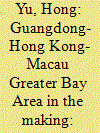

|
|
|
|
|
| Summary/Abstract |
The Chinese authority intends to develop the Guangdong-Hong Kong-Macau Greater Bay Area (GBA) as a new engine to sustain Chinese development. By applying the theories of state rescaling and city-cluster formation, this paper intends to conduct a case study of the GBA to examine the state-initiated plan for city-cluster formation in China, to analyse the Chinese central and local governments’ efforts to put this plan into action and the hurdles they face in formatting this city-cluster. The formulation of the GBA development plan for integrated development reflects a dynamic process of upscaling and downscaling of various levels of state power. The state’s plan for the GBA is to create a world-class city-cluster, and to eliminate barriers that hinder the free flow of goods and resources. Nevertheless, it will be challenging for Guangdong, Hong Kong and Macau, which fall under different administrative regions and customs zones, to achieve the level of collaboration and functioning required for integrated development of the GBA. The fierce competition for dominance among these core cities could jeopardise efforts to forge closer economic integration in the region.
|
|
|
|
|
|
|
|
|
|
|
|
|
|
|
|
| 4 |
ID:
153392
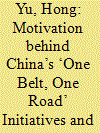

|
|
|
|
|
| Summary/Abstract |
The ‘One Belt, One Road’ (OBOR) initiatives form the centerpiece of the Chinese leadership’s new foreign policy. The OBOR initiatives are a reflection of China’s ascendance in the global arena, economically, politically, and strategically. Developing inter-connectivity of infrastructure development forms a central part of China’s OBOR initiatives. The Asian Infrastructure Investment Bank (AIIB) aims to facilitate and accelerate infrastructure improvement in the region by providing capital loans and technical services. The AIIB will serve as the spearhead of China’s OBOR initiatives. The AIIB and OBOR initiatives have put China at the center of geoeconomics and geopolitics in the region and beyond, a position from which it hopes to strengthen its economic ties with other Asian countries. The new Silk Road initiatives also provide a channel for Chinese companies and capital to invest in other countries by leveraging China’s strengths in infrastructure development, financial power and manufacturing capacity. The OBOR initiatives and the AIIB could change the economic and political landscape of Asia, the most dynamic and economically vibrant region of the twenty-first century. However, China faces serious challenges, both internally and externally, in implementing these initiatives.
|
|
|
|
|
|
|
|
|
|
|
|
|
|
|
|
| 5 |
ID:
141455
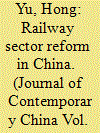

|
|
|
|
|
| Summary/Abstract |
The railway sector in China has undergone several major rounds of reform and institutional restructuring since 1986. These reform initiatives have largely been unsuccessful due to strong resistance from vested interest groups. The development of China's railway sector has raised some challenging issues that include the centralization of power in the Ministry of Railways (MOR), state monopoly control, rampant corruption and the accumulation of a huge debt burden. The 2013 railway reform initiatives have provided very little in the way of concrete measures to deal with these thorny issues but have instead created more controversy and problems in an already crisis-ridden sector. For the railway industry, the transformation from the mixed-function MOR to a monopolistic China Railway Corporation (CRC) will not necessarily lead to better railway management.
|
|
|
|
|
|
|
|
|
|
|
|
|
|
|
|
| 6 |
ID:
170380
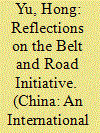

|
|
|
|
|
| Summary/Abstract |
The grand "Belt and Road Initiative" (BRI), comprising various routes by land and by sea, is a globally oriented outreach strategy intended to connect China with the world. Essentially, the BRI is about global outreach, connecting the world with China as the core hub. The initiative is known in Chinese as "Yi Dai Yi Lu" ("One Belt, One Road") but in practice, it encompasses multiple routes along the BRI, connecting various specific countries and regions, transportation modes and industrial sectors. China has the financial resources, the technology, the manpower, and most importantly, the political will and strategic vision to support infrastructure development in developing countries. Nevertheless, the BRI is currently at a crossroads. The tremendous enthusiasm for the promise of increased infrastructure connectivity and trade promotion under this initiative has begun to subside. Indeed, the implementation of the BRI has faced various practical issues and serious challenges.
|
|
|
|
|
|
|
|
|
|
|
|
|
|
|
|
| 7 |
ID:
144751
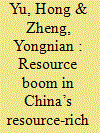

|
|
|
|
|
| Summary/Abstract |
State-owned enterprises’ unchecked resource exploitation and the Chinese state’s GDP-dominated mentality have played pivotal roles in causing and perpetuating social and environmental problems in the country’s resource-rich provinces. The authors propose a “resource curse theory with Chinese characteristics” to analyze the role of the state and the impacts of state-owned enterprises.
|
|
|
|
|
|
|
|
|
|
|
|
|
|
|
|
|
|
|
|
|